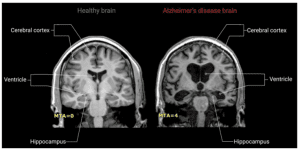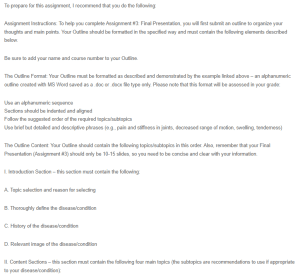Outline – Alzheimer’s Disease
Introduction Section
-
-
Topic Selection and Reason for Selecting
-
- Alzheimer’s disease (AD) has an increasing prevalence and is becoming an important cause of morbidity among aging populations worldwide.
- Personal interest in neurodegenerative disorders and their societal implications
-
Defining the Condition
-
- AD is a progressive neurodegenerative disorder manifesting as memory loss, cognitive decline, and behavioral changes (Monfared et al., 2022)
- Constitutes 60-80% of all dementia cases
-
History of the Condition
-
- First described by Dr. Alois Alzheimer in 1906 after observing a patient named Auguste Deter.
- Progression of understanding over the 20th and 21st centuries, including the discovery of beta-amyloid plaques and neurofibrillary tangles
-
Relevant Image
-

Note. AD is associated with shrinkage of the hippocampus and dilation of the ventricles. The left is the healthy brain, while the right is the brain of an individual affected by Alzheimer’s disease. AD causes a reduction in hippocampal size, a reduction in the size of the cerebral cortex, and an increase in ventricle size. MTA: Medical temporal tested lobe: MTA = 0: No atrophy in medial temporal lobe indicated by non-significant volume loss of hippocampus; MTA = 4: Severe volume loss of hippocampus indicating medial temporal tested atrophy. From “Imaging Techniques in Alzheimer’s Disease: A Review of Applications in Early Diagnosis and Longitudinal Monitoring,” by W. M. van Oostveen and E. C. M. de Lange, 2021, International Journal of Molecular Sciences, 22(4), p. 16 (https://doi.org/10.3390/ijms22042110).
-
Content Section
-
Statistics/Epidemiology
- Statistical Prevalence
-
- More than six million people are affected by AD in the US (Alzheimer’s Association, 2022).
- One in nine people among individuals aged 65 and above has AD.
- AD prevalence in the US is expected to rise to 13 million by 2050.
-
Types of Determinants
- Determinants include:
-
- Biological Determinants: Genetics, age, family history, and gender (higher prevalence in women).
- Environmental Determinants: Exposure to pollutants, toxins, and lifestyle factors such as diet and physical activity.
- Social Determinants: Education level, socioeconomic status, and access to healthcare services.
- Behavioral Determinants: Smoking, alcohol consumption, physical inactivity, and cognitive engagement.
- Psychological Determinants: Mental health conditions like depression and chronic stress.
- Healthcare System Determinants: Availability and accessibility of diagnostic tools, treatment options, and preventive measures.
- Risk Factors
- Age: The most potent identified RR; a doubled RR for every five years of life beyond the age of 65.
- Family history and genetics, e.g., APOE ε4 gene
- Cardiovascular factors: Hypertension, high cholesterol, diabetes
- Boolean factors: Sedentary lifestyle, poor dieting, smoking
- Costs
- Costs to the Individual/Family
- Costs
- Emotional toll: Stress, depression, and burnout
- Financial burden of long-term care and medical expenses
- Loss of independence and quality of life
- Possible Costs to Society
- Projected to reach $1 trillion by 2050 in the US (Skaria, 2022)
- In 2022, AD and other dementias cost the nation $321 billion
- Loss of Productivity in the Workforce
- Early retirement and reduced work capacity of patients
- Caregivers reducing work hours or leaving jobs to provide care
- Estimated 18.6 billion hours of unpaid care provided by family and friends in 2021
-
Anatomy and Physiology/Etiology
- Affected Parts of the Body
-
- Brain: Cerebral cortex and hippocampus
- Progressive damage to neurons in multiple brain regions
- Description of the Normal Structure and Function of Affected Body Parts
- Neuronal communication via synapses and neurotransmitters
- Hippocampus role in memory formation and consolidation
- Cerebral cortex functions in cognition, reasoning, and behavior
- How AD Changes the Normal Structure and Function of Affected Body Parts
- Accumulation of beta-amyloid plaques between neurons (Centers for Disease Control and Prevention, 2020; National Institute on Aging, 2023)
- Formation of neurofibrillary tangles within neurons (tau protein aggregation)
- Neuronal death and brain atrophy, particularly in the hippocampus and cortex
- Disruption of neurotransmitter systems, especially acetylcholine
- Cause(s) of the Condition
- Complex interplay of genetic, environmental, and lifestyle factors
- Amyloid cascade hypothesis and tau hypothesis (Centers for Disease Control and Prevention, 2020; National Institute on Aging, 2023)
- Vascular contributions and neuroinflammation
- The exact cause is still not fully understood, likely multifactorial
-
Diagnosis/Treatments/Prognosis
- Diagnosis
-
-
- Clinical evaluation and cognitive tests. Examples include MMSE and MoCA
- Brain imaging: MRI for structural changes, PET scans for amyloid/tau
- Biomarker analysis: Cerebrospinal fluid Aβ42, total tau, and phospho-tau
- Genetic testing for familial AD
- Treatment
- FDA-approved drugs for mild to moderate AD: Cholinesterase inhibitors like donepezil, rivastigmine, and galantamine
- Memantine for moderate to severe AD
- Combination therapy: Cholinesterase inhibitor + memantine
- Non-pharmacological approaches: Cognitive stimulation, physical exercise, social engagement
- Emerging disease-modifying therapies targeting amyloid and tau proteins (Monfared et al., 2022)
- Lifestyle interventions to reduce risk or slow progression
- The Prediction (Prognosis)
- Average life expectancy of 4-8 years after diagnosis can be up to 20 years
- Progressive decline in cognitive and functional abilities
- Increased susceptibility to infections and other health complications
- Eventual loss of ability to perform basic daily activities and communicate
-
Conclusion
- AD is a growing public health concern affecting millions worldwide, with numbers expected to rise significantly.
- Substantial economic and societal burden, projected to reach $1 trillion annually by 2050 in the US
- Complex pathophysiology involving protein accumulation, neuronal death, and disruption of brain function
- Diagnosis relies on clinical evaluation, cognitive testing, biomarkers, and brain imaging.
- Current treatments focus on symptom management, with promising disease-modifying therapies in development.
- A multifaceted approach is needed, including research, early detection, and public health initiatives. Notably, continued research is crucial for improving diagnosis, treatment, and potentially prevention of AD
References
Alzheimer’s Association. (2022). 2022 Alzheimer’s disease facts and figures. Alzheimer’s & Dementia, 18(4), 700-789. https://doi.org/10.1002/alz.12638
Centers for Disease Control and Prevention. (2020, October 26). Alzheimer’s disease and related dementias. CDC. https://www.cdc.gov/aging/aginginfo/alzheimers.htm
Monfared, A. A., Byrnes, M. J., White, L. A., & Zhang, Q. (2022). Alzheimer’s disease: Epidemiology and clinical progression. Neurology and Therapy, 11(2), 553-569. https://doi.org/10.1007/s40120-022-00338-8
National Institute on Aging. (2023, April 5). Alzheimer’s disease fact sheet. National Institute on Aging. https://www.nia.nih.gov/health/alzheimers-and-dementia/alzheimers-disease-fact-sheet
Skaria, A. (2022). The economic and societal burden of Alzheimer disease: Managed Care Considerations. The American Journal of Managed Care, 28(Suppl 10), S188-S196. https://www.ajmc.com/view/the-economic-and-societal-burden-of-alzheimer-disease-managed-care-considerations
van Oostveen, W. M., & de Lange, E. C. M. (2021). Imaging techniques in Alzheimer’s disease: A review of applications in early diagnosis and longitudinal monitoring. International Journal of Molecular Sciences, 22(4), 2110. https://doi.org/10.3390/ijms22042110
ORDER A PLAGIARISM-FREE PAPER HERE
We’ll write everything from scratch
Question 
To prepare for this assignment, I recommend that you do the following:
Assignment Instructions: To help you complete Assignment #3: Final Presentation, you will first submit an outline to organize your thoughts and main points. Your Outline should be formatted in the specified way and must contain the following elements described below.

Outline – Alzheimer’s Disease
Be sure to add your name and course number to your Outline.
The Outline Format: Your Outline must be formatted as described and demonstrated by the example linked above – an alphanumeric outline created with MS Word saved as a .doc or .docx file type only. Please note that this format will be assessed in your grade:
Use an alphanumeric sequence
Sections should be indented and aligned
Follow the suggested order of the required topics/subtopics
Use brief but detailed and descriptive phrases (e.g., pain and stiffness in joints, decreased range of motion, swelling, tenderness)
The Outline Content: Your Outline should contain the following topics/subtopics in this order. Also, remember that your Final Presentation (Assignment #3) should only be 10-15 slides, so you need to be concise and clear with your information.
I. Introduction Section – this section must contain the following:
A. Topic selection and reason for selecting
B. Thoroughly define the disease/condition
C. History of the disease/condition
D. Relevant image of the disease/condition
II. Content Sections – this section must contain the following four main topics (the subtopics are recommendations to use if appropriate to your disease/condition):
A. Statistics/Epidemiology
1. Statistical prevalence (e.g., overall, gender, age)
2. Types of determinants (e.g., risk factors)
B. Costs
1. Costs to the individual/family (e.g., mental, physical, emotional)
2. Possible costs to society (dollar figures)
3. Loss of productivity in the workforce
C. Anatomy & Physiology/Etiology
1. Which parts of the body are affected [e.g., tissue(s), organ(s), and/or organ system(s)]
2. Description of the normal structure and function of affected body parts
3. How the disease/condition changes the normal structure and function of affected body parts
4. Cause(s) of the disease/condition
D. Diagnosis/Treatments/Prognosis
1. How this disease/condition is diagnosed (e.g., history, exam, diagnostic imaging, labs)
2. How the disease/condition is treated (e.g., traditional medical treatments, alternative methods of treatment)
3. The prediction (prognosis) of this disease/condition’s outcome (e.g., life expectancy, if treated, vs. untreated)
III. Conclusion Slide – this section must contain four to six bulleted points that sum up all of the main topics/subtopics (statistics/epidemiology, costs, anatomy & physiology/etiology, diagnosis/treatments/prognosis) from the body of your presentation.
IV. Reference Section
Include a final “References” list of a minimum of five (and no more than 10) academically and scientifically credible sources used for facts shared in your Outline. (Not including images or other media.)
Include a final “Media References” list of all images, videos, graphs, audio elements, etc., that you want to use within your Outline.
All references included in the reference lists should be cited internally within the Outline and vice versa.
For guidance on how to format your references properly in APA style, please click here: http://owl.english.purdue.edu/owl/resource/560/05/
If you are using an electronic source, click here: https://owl.purdue.edu/owl/research_and_citation/apa_style/apa_formatting_and_style_guide/reference_list_electronic_sources.html
Important Note: APUS discourages the use of auto-citation tools (e.g., citation generators) by students enrolled in 100- and 200-level courses because the University believes students need to learn and understand the reasons for citing sources used in their work, as well as how to cite sources correctly.
V. Internal Citations
These are not listed on a separate page but instead placed throughout the Outline via in-text citations anytime you paraphrase, use direct quotes, or want to use visual/audio components from other sources. Therefore, all source material should be cited.
All internal citations listed within the Outline should be included in the reference lists and vice versa.
If you are not sure what in-text citations are and how to format them, please visit this link from the Trefry Library (click the section labeled ‘IN-TEXT CITATIONS | FORMAT’): https://www.apus.edu/apus-library/resources-services/Writing/writing-center/apa-style-guide-info.html
For more information on how to format in-text citations, click here: https://owl.purdue.edu/owl/research_and_citation/apa_style/apa_formatting_and_style_guide/in_text_citations_the_basics.html
NOTE: Work that is improperly cited and referenced or lacking either in-text citations or references may not be accepted for credit. Ask me questions!
Writing Expectations: Apply scientific concepts and use scientific terminology correctly. Utilize proper spelling, grammar, and punctuation.
